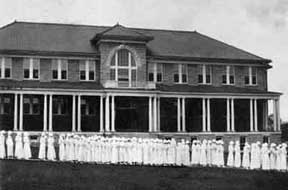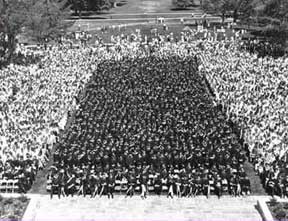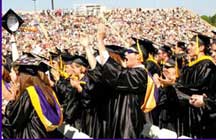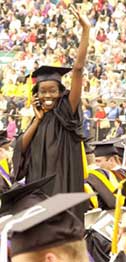It has been shortened, lengthened, moved, held inside, held outside, held in a courthouse, held in a movie theater, rained on – and even snowed on in May.
But, despite changes, commencement has remained an important part of James Madison University since the first program was held on a Tuesday morning, June 14, 1910. At that commencement, held in the assembly hall of the Harrisonburg courthouse, students received one-year certificates.
For the first commencement, students all wore white dresses with long sleeves and high collars that the faculty deemed appropriate for the occasion. Virginia Governor William Hodges Mann was the main speaker, and the house was packed.

The exercises were moved in 1915 to the new Virginia Theatre in downtown Harrisonburg. Students and faculty marched downtown from the then State Normal School for Women on Main Street in a “Normal Line.”
The first commencement on campus was held in 1916 in the new auditorium of the Students' Building (now Harrison Hall). The academic procession formed between Science Hall (now Maury Hall) and Hillcrest. The seniors were dressed uniformly in white, with their skirt lengths regulated by the faculty. Non-graduating students were asked to stay for commencement and formed the aisle through which faculty marched in academic regalia.
In 1917, seniors asked if they could wear caps and gowns. The following year, the faculty voted by a margin of one against the students wearing academic robes. The matter was then referred to a committee for study and recommendation.

The faculty reconsidered and when the first bachelor's degrees were awarded in 1919, graduates wore caps and gowns. As each received her degree, the student knelt on a small stool in front of the president. The president placed a hood over her shoulders.
In 1922, the first summer school commencement was held in the campus amphitheater (which no longer exists). Twenty women graduated during the ceremony, which was the first outdoor college commencement ever held in Virginia .
Until 1927, exercises were held in the outdoor amphitheater. Then the gymnasium in Reed Hall (now Keezell Hall) was used until Wilson Hall was completed.
The first commencement in Wilson Hall Auditorium was for the 1931 summer graduation when 114 students graduated, the largest class to that time. During the late-1920s and early-1930s, a weeklong commencement program was observed. Baccalaureate vespers, receptions, dances and banquets all led up to the commencement.

Summer commencements were stopped after 1937 and were not held again until 1949. They continued from 1949 to 2000 when they were again discontinued.
All graduation activities were shortened in 1928 after two seniors were killed two weeks before graduation when a school automobile transporting them was hit by a train at the railroad crossing on Grace Street. The women were awarded degrees posthumously.
In the late-1930s, the increased enrollment at the school forced the discontinuance of requiring non-graduating students to remain for the commencement program.
Commencement continued during World War II but the 1944 ceremony was abbreviated. During the 1950s, commencement week was shortened to a commencement weekend. Vespers, faculty receptions, dinner, class-day activities, garden reception, music recital, senior breakfast, picnic, dance and graduation were all held. Graduation was moved to Sunday.
In 1959, commencement was held for the 50th time. It was held on a Sunday afternoon in Wilson Hall Auditorium and each senior was allowed four reserved seats for guests.
The 1962 graduating class of 202 members lined up on the sidewalk in front of Jackson Hall to proceed to Wilson Hall. Prior to the graduation, the seniors gathered on Friday on the Quadrangle to form an “M” and sing the Alma Mater.
In 1970, President G. Tyler Miller, who retired in December of that year, presented diplomas for his final time.

The new president, Ronald E. Carrier, presented diplomas in 1971 to the graduates and began his tradition of shaking hands with each graduate. Even when graduating classes exceeded 2,000 students, Carrier continued shaking hands with each graduate until the separate college ceremonies began in 1993. (It is estimated that Carrier shook hands with more than 35,000 graduates during his presidency.)
In Carrier's first year as president, the commencement ceremony was moved to the front of Wilson Hall. May ceremonies were held on the Quadrangle until 1988, when they were moved to Bridgeforth Stadium. Summer commencements continued to be scheduled for the Quadrangle until they were discontinued after the 2000 ceremony.
In 1977, 1,300 students graduated in the last class whose members had Madison College on their diplomas. Students had the choice of either Madison College or the new James Madison University name on the document. Ninety-four graduates requested diplomas with the new name. See Name Changes and Graduation.
Throughout the history of JMU graduations, there had always been one main speaker at each ceremony. In the May 1984 ceremony a new approach was tried and there were three speakers: a student's parent, a faculty member and a graduating senior.
The speakers were: Kirby L. Cramer, father of a graduating senior and chairman of Hazleton Laboratories Corp. (and later JMU Board of Visitors member); Dr. Ralph A. Cohen, then an associate professor of English; and Isabel M. Cumming, president of the Student Government Association and a graduating senior.
With an increasing number of students completing their degree requirements at the end of first semester, the university was asked to begin holding a graduation ceremony in December.
The first December Commencement was held in 1985 in Wilson Hall Auditorium with President Carrier as the speaker. The crowd, however, far exceeded expectations and many guests were unable to get into the auditorium.
The following year, December Commencement was moved to the JMU Convocation Center. More than 500 students now receive degrees annually in December with audiences in excess of 5,000.
By the 1980s, the increasing size of the May graduation class and graduation crowds led to a suggestion to have a universitywide ceremony with a main speaker that would be followed by individual ceremonies for colleges, where students would be recognized individually. The idea was rejected after many objections arose from students.
Graduation remained on the Quadrangle but crowds continued to grow and became too large to accommodate effectively. At the last May Commencement on the Quadrangle in 1987, an audience of about 12,000 crowded onto the Quad. Most could neither clearly see nor hear the speaker, Virginia Governor Gerald L. Baliles.
The following year, the ceremony moved to Bridgeforth Stadium where the guest speaker was Robert “Phoef” Sutton, a 1981 JMU graduate and a successful television writer/producer (“Cheers” and “Newhart,” among other shows).
With graduating classes of more than 2,000, the practice of having each graduate walk across the stage for individual congratulations created ceremonies that lasted almost three hours.

To shorten the main ceremony and still give individual recognition to graduates, the university developed a series of individual college ceremonies that following the main ceremony.
The first graduation with separate college ceremonies was in 1993. The universitywide ceremony was held in Bridgeforth Stadium, with Virginia Governor L. Douglas Wilder presenting the main address. Following that program, each college had its own ceremony where students were recognized individually and shook hands with their dean and other college officials.
College ceremony locations have included Wilson Hall Auditorium, the JMU Convocation Center, the Quadrangle, Hillside Field, Godwin Hall, and the Festival Conference and Student Center Lawn.
Summer commencements were held from 1922 to 1937 and from 1949 to 2000. The programs were discontinued in 2000 because of low participation by graduates. While 500-600 students completed their work in the summer each year, only 200-300 attended the ceremonies.

Students who finished their degree requirements in the summer were given permission to participate – or “walk” – in the May ceremony and many graduates took that option, lowering the summer turnout significantly.
Former President Ronald E. Carrier has spoken by far at the most JMU ceremonies – an even dozen, four each in May, summer and December.
With outdoor May and July/August ceremonies from the early 1970s into the 21st century, weather often played a major role.
The last two summer commencement scheduled for the Quadrangle both had to be moved to the Convocation Center because of weather – for rain in 2000 and high temperatures in 1999.
Rain has fallen during many ceremonies with the heaviest in May 1994, when rain fell steadily throughout the program in Bridgeforth Stadium. Only around 7,000 – a third of the usual audience – attended the ceremony, but thousands of others watched the activities on closed-circuit television at several sites around campus.
The speaker at the rain-plagued 1994 ceremony, U.S. Senators John W. Warner demonstrated why he has been elected to the Senate since 1978. Warner spoke for only minutes and announced, to the cheers of a drenched audience: “Sometimes political figures should be seen and not heard. I will not give my speech.”
The strangest weather story for commencement occurred in May 1989 when the main speaker in Bridgeforth Stadium was Michael G. Gartner, president of NBC News. The temperature had hovered in the upper 30s and low 40s all morning.
Even though it was May 7 in the South, light snow swirled around the stadium during Gartner's address.
Sources:
“Graduation Has Changed Since 1910,” by Janet T. Wendelken in the James Madison News, May 5, 1983.
Madison College : The First Fifty Years, 1908-1958 by Dr. Raymond C. Dingledine Jr.
Madison College and James Madison University news releases.
